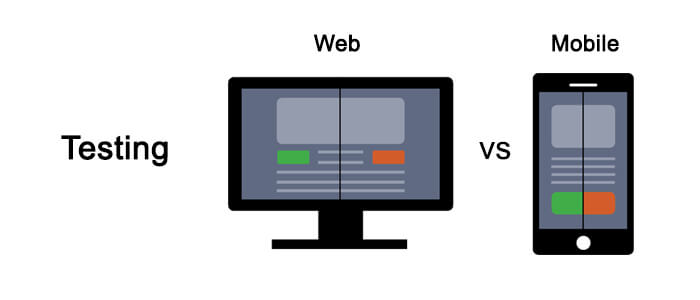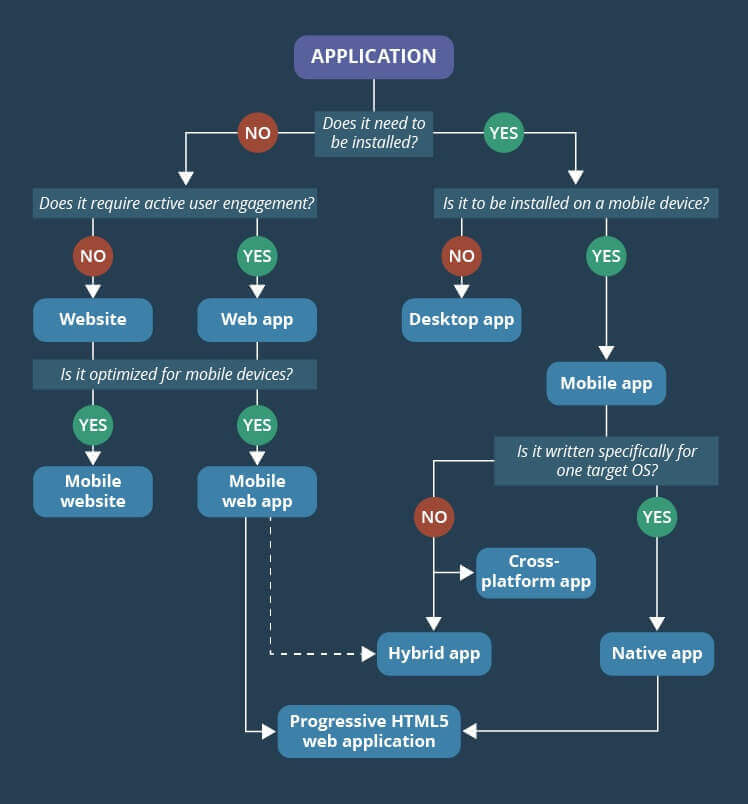In the current world, we have multiple choices to view any application. If we want to go through any website on a large screen, we can view it on a desktop.
On the other hand, if we don’t want to spend our time opening the desktop and viewing the website via the browser, we can simply open the website on our Smartphone browser which makes it easy for us to go through any website and get the details. One step ahead in that technology era! Now we have native apps as well to get through any information from the internet.

Types of Application and Application Testing
In this discussion, we will discuss the types of applications we have. And from the point of view of Software testing services differs in approaches to testing different types of applications.
Let’s first discuss the types of applications. So basically there are 3 types of applications.
- Web Application
- Mobile Application
- Desktop Application
An Image to understand it in better way by ScienceSoft

1. Web Applications
The web application that runs within a browser! This is the application that entirely resides on the server and to access the application, we need a platform i.e. browser.
Taking an example of one of the applications is Facebook which is ultimately a package of multiple corresponding pages which runs on a browser. A web application is being used on various devices i.e. mobile, tablet, and desktop with different configuration which is only limited to a web browser and internet connectivity. If the application is compatible across screen resolutions, you can easily view and access your application.
2. Mobile Application
In the mobile application we have
- Native Application
- Mobile web Application
- Hybrid Application
Native Application
Native Application is an application that is built to run independently on mobile devices. An app does not require any base like a browser to run on a device. Commonly nowadays we have 2 platforms either iOS or Android and there is a small bunch of users on windows mobile as well as Blackberry which is gradually decreasing in quantity as the majorly of the market is taken care of by iOS and Android mobile operating systems. A small example of a native mobile app is an SMS app or in terms of installable apps Temple Run.
Basically, an app built up for a particular system like iOS, Android, etc, and that cannot be used on other than its own platform. One of the major advantages of native apps is Native apps are high in performance and ensures a good user experience and easy to achieve the targets of an end-user. And the higher cost is one of the cons of a native app.
Creating native apps is high in cost to build as compared to other types of applications.
Mobile Web Application
A Mobile web application is just a web application that we run on a mobile browser and access the application view browser on mobile devices. For accessing the mobile web application, you just need a mobile device to have a web browser installed on it and your mobile should be connected to the internet.
Hybrid Application
A hybrid application is an application that builds on different technology as compared to native apps, look and feel remain almost the same. The difference occurs in the performance of the application where you can experience the slowness while accessing the hybrid application.
3. Desktop Application
An application that runs on the computer is its own environment and configuration. This application is an executable file that you have to execute on a computer to view its content and access the application. In terms of testing the desktop application, you need to be focused broadly on UI and a functional layer, as well as Load/Performance, which plays an important role here. You have to focus on the system hardware part as well. For example, how much memory consumption is there when running your application, and what is the status of your RAM consumption.
Now the point occurred when coming to the software testing profession, what makes the difference between testing of mobile applications and web application testing.
Difference between Mobile App Testing and Web Application Testing
Mobile App Testing
When testing the mobile application, there are many constraints that you need to look at while testing. A mobile app development company must prioritize user experience as one of the major assets in an application. Your application may be bug-free but if the user experience is not good, that does not worth it. Some of the major areas we have to look into are our mobile app testing which does not make much importance in web application testing.
Installation/Un-installation testing:
This kind of testing you can cover in smoke testing. You need to make sure that you can be able to install and uninstall the application on all supportive devices and that the application is useful and does not have any upfront crashing. You have to also make sure that when you uninstall the application, your app folder should also get deleted from the file manager when working with the Android operating system.
Network Testing
You need to be very sure about the application’s network performance. You need to test your application in all aspects like in 4G, 3G, Wi-Fi, and edge. Avoid fatal errors, and apply preventive checks on all necessary and security-related modules in low network or non-network.
Device Compatibility
Your application should be compatible with all kinds of operating systems versions and device screen resolutions. For example, if you have an iOS application, the application should work appropriately on all supportive iPhones, and iPad and with minimum supportive iOS version to the latest available iOS version.
Memory Testing
In your testing, memory is one of the major aspects where most applications lacking in the industry. We have to be aware of the memory leaks and RAM consumption from your application. And also make sure to reduce app size as lower as possible.
Native and hybrid apps testing
Native and hybrid apps may be built on different technologies but they serve almost similar features. The testing approach for both applications would be the same as both supports mobile platforms.
Installation testing: Both applications need to be tested based on installation as both are installable files in devices.
When talking about the next step in testing, we just follow the testing approach suitable for mobile applications as below:
- User interface testing
- Functional testing
- Compatibility testing
- Network testing
- Interruptions testing
- Performance testing
- Notification testing
- Gesture testing
- Memory leaks check
Web Application Testing
Cross browser testing and Compatibility Testing: For a web application, you have to ensure that your application having expected look and feel on all supportive browsers with has combinations of different operating systems. In parallel, you have to also make sure that the application should have the same look and feel in shorter screen resolution devices like mobile and tablets as well.
Security Testing & Link checks: In terms of security testing, you have to make sure about the user session is working as expected but longer time duration. Your application must have broken links free. There are many online tools available that are too open source. You can use them to check the broken links in your application. Identify the broken links and try to avoid them.
Cookies Testing: There are small files getting stores in your temporary folder that are called cookies which are used to maintain the user session of your application. You have to ensure the functionality by checking in both ways i.e. on and off cookies in your browser settings.
These are a few points that need to be should take care of during web application testing. These are the additional testing but by covering these points don’t forget to follow the testing life cycle and testing process which covers all required testing types in the Quality Cycle.
What’s in the Future of Mobile and Web application Testing?
With the growing number of mobile users, app testers are focusing more on innovative ways to enhance the app. This also affects the software testing ecosystem and makes it a bit complex for the app testing team. In addition, to overcome this challenge, software companies are adding agility to their software development process. They are now emphasizing enhancing the quality and performance of their mobile apps to get a success story. Partnering with a trusted mobile app development company New York can help businesses integrate advanced testing practices from the very beginning, ensuring long-term reliability and better user engagement.
When we talk about the future, it calls for robust front-end and back-end app testing. Web-based application testing needs several QA checks at both API level and UI level. Testing teams need to be proficient in applying tools during several layers of the app. Testers will be able to perform several test cases in no time using the right software testing tools.
AI and ML Technology Use in Testing
While software companies will be using agile methods to stay ahead, the use of AI and ML in IT software testing is the latest trend. However, these methodologies are still available in the market and IT software testing companies are using these technologies with the acknowledgment of undiscovered areas.
Software companies are calling QA teams for early development stages. The companies now understand the need for involving QA testers in the early software development stages to fill the gap between software development and software testing needs.
The future of web app testing and mobile app testing involves more use of test automation. With test automation, software companies can ensure faster delivery of premium apps that will grow their business. With the availability of advancements and upgrades, testers need to work on their skills and work on how quality assurance can become a part of the software development stage.



